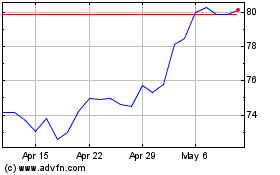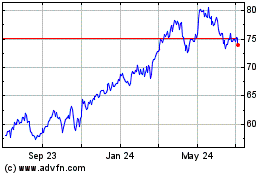By Ryan Tracy and Leslie Scism
U.S. officials are considering whether to remove federal
oversight of insurer American International Group Inc., according
to people familiar with the matter.
The Financial Stability Oversight Council, a group of senior
regulators, was set to discuss the matter at a meeting Friday,
these people said. No final decision has been made, and the outcome
of the discussion isn't certain, they said.
It is possible the council could decide not to vote on the
matter Friday, delaying the decision until a future meeting.
Removing stricter oversight of AIG would be a symbolic step: The
company was at the center of the global markets meltdown in 2008
and was effectively nationalized through a government bailout that
topped $180 billion. That made it a poster child for financial
excesses, and was one of the reasons for the creation of the
oversight council in the 2010 Dodd-Frank financial regulatory
law.
In 2013, the oversight council determined AIG posed a risk to
the economy and designated it a "systemically important financial
institution," or SIFI. It was the first time the council had used
its main Dodd-Frank power. The label subjects AIG to stricter
oversight than it would otherwise face, including supervision by
the Federal Reserve.
The oversight council is required to review SIFI designations
each year. Under the Trump administration, discussions about
whether to remove the tag have become more active this year, the
people familiar with the matter said.
To remove the SIFI label, officials would have to determine that
distress at AIG no longer poses a risk to U.S. financial
stability.
The company is about half the size it was during the government
rescue, slimming down to $499.76 billion in total assets as of June
30, from $1.048 trillion in 2007. It has divested itself of dozens
of businesses, though it remains one of the biggest sellers of
property-casualty insurance to businesses world-wide, and is also a
major seller of life insurance and retirement-income products in
the U.S.
Its turnabout was hard to imagine in 2008, when many government
officials and industry executives expected it to go out of
business.
U.S. officials said the rescue of a teetering AIG was necessary
because the company was so financially entangled with other firms
around the world that its collapse could have unpredictable
effects. The bailout's initial terms proved so harsh for AIG that
the aid package was later restructured.
AIG fully repaid taxpayers by the end of 2012. Its divestitures
included crown-jewel life-insurance operations that spanned the
globe and the sale of one of the world's biggest aircraft-leasing
businesses. More recently, it sold a mortgage-insurance unit.
For many years, AIG had taken a glass-is-half-full approach to
its SIFI designation, even as competitor MetLife Inc. successfully
overturned its designation in federal court, arguing it had been
unfairly applied and was harmful to its competitive position.
Former AIG Chief Executive Peter Hancock repeatedly emphasized
that the global insurer needed a lead regulator, and the Fed fit
the bill, referring to the central bank as a "helpful partner." Mr.
Hancock also disputed that the Fed was hampering the company with
too-tough capital requirements, saying that AIG aspired to high
standards of its own choice to maintain solid credit and
financial-strength ratings.
Mr. Hancock left the company earlier this year and was succeeded
by industry veteran Brian Duperreault. In an August earnings call,
Mr. Duperreault signaled a change in approach, reflecting AIG's
years of shrinkage and efforts to improve risk controls.
He responded to a question about the SIFI designation by saying
that AIG today "would not meet the hurdles" for the label. "This
company has dramatically changed its risk profile and controls
since the financial crisis," he said. "We will continue to work
with our numerous regulators to demonstrate the substantial and
successful de-risking that AIG has achieved," he added.
AIG's rescue was so high-profile and controversial that people
in public policy say it helped usher in significant changes in the
nation's politics. On the right, the federal government's
intervention in the economy helped spawn the tea-party movement. On
the left, it helped seed the Occupy Wall Street movement, which
contended the government aided rich bankers while giving short
shrift to struggling homeowners, among other things.
The Financial Stability Oversight Council currently has 10
voting members, including the Treasury Secretary and the heads of
major regulators such as the Fed. Five were appointed by President
Barack Obama and five by President Donald Trump. The Obama
appointees may be more inclined to maintain federal oversight of
AIG.
It will take a two-thirds vote of the oversight council to
remove AIG's SIFI designation, and people familiar with the matter
said they were uncertain Thursday how a vote would play out.
Seven of the 10 voting members would typically have to elect to
rescind the SIFI tag, but Securities and Exchange Commission
Chairman Jay Clayton may need to recuse himself from the AIG vote,
some of the people said, because his former law firm Sullivan &
Cromwell LLP counts AIG as a significant client. Council members
have been discussing how Mr. Clayton's potential recusal would
affect a vote, people familiar with the matter said.
A spokesman for Mr. Clayton declined to comment Thursday.
"If they decide to keep it a SIFI, it will be based upon
politics, based upon notions of what AIG used to be, which is
dramatically different from today's AIG," said Thomas Russo, who
was a general counsel at AIG during the turnaround, from 2010 to
2016.
Write to Ryan Tracy at ryan.tracy@wsj.com and Leslie Scism at
leslie.scism@wsj.com
(END) Dow Jones Newswires
September 21, 2017 18:25 ET (22:25 GMT)
Copyright (c) 2017 Dow Jones & Company, Inc.
American (NYSE:AIG)
Historical Stock Chart
From Mar 2024 to Apr 2024

American (NYSE:AIG)
Historical Stock Chart
From Apr 2023 to Apr 2024
